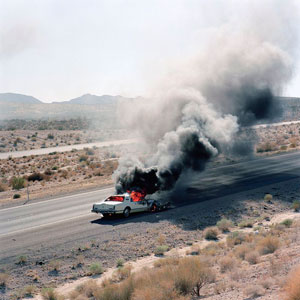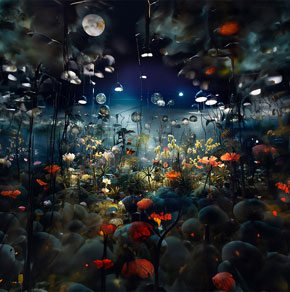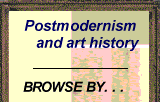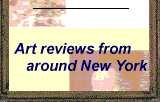Photography as Spectacle
John Haberin New York City
Weegee, Jeff Brouws, and Mary Mattingly
You may remember Weegee for one thing, a freak show, but never forget: freaks are people, too. They may even be celebrities.
With wide eyes and contorted faces, they are not a pretty picture, but society's picture all the same. Riven by shadow, they are used to stage lighting as well. In a retrospective subtitled "Society of the Spectacle," at the International Center of Photography, they become more and more glamorous, too. Above all, a freak show is a show, and Weegee sees one on both sides of the camera, as the paparazzi crowd in. The ambiguity between photojournalism and dark comedy has haunted photography ever since.  Just this last fall, Jeff Brouws dares you to find anything wrong in the American scene, while Mary Mattingly watches the dark side of the natural world come out at night.
Just this last fall, Jeff Brouws dares you to find anything wrong in the American scene, while Mary Mattingly watches the dark side of the natural world come out at night.
Both sides of the camera
Weegee had one name but many lives, much like the New York he portrayed in photography, and yet he kept coming back to the spectacle, much like the city itself. Born Arthur Fellig in Ukraine at the turn of the century, he made a career as the police photographer who kept one step ahead of the police. It gave him a name compounded from Ouija and squeegee, for the man with a police-band radio, a sixth sense, and whatever tools it took to make the streets his darkroom. If the cops had their perp walk, Weegee was there, with his cigar and flashbulb. Chasing fires, crime, and car wrecks, he might even get there first. He took his self-portrait in a police van, staring right back.
This was the New York street photography of Helen Levitt and William Klein, with an emphasis on the urban underground. It anticipates the madness of Diane Arbus and Garry Winogrand still to come. He called his first book, in 1945, Naked City—but then, in 1947, he packed up for Hollywood, where crime was legit because you could make it up. He joined the wall of photographers at a press opening, and he turned the camera around to capture them as well. You can all but hear the flash go off. It penetrates the Hollywood darkness as far as he wished to go.
The curator, Clément Chéroux of the Fondation Henri Cartier-Bresson, describes a second career. I am not so sure. His technique stayed the same, with a strong depth of field and extreme contrasts in brightness. When he photographs a fire, smoke can be anything from mud gray to the reflection off the firefighters' lights. In LA, the men wear white shirts and black ties, and stage lights are just part of the show. In his last decade, the 1060s, Weegee left for Europe and yet another life, but where would Paris be without the night?
The show draws freely on ICP's collection, with the Weegee Archive, which it owns. It takes its publicity image from LA, but the rest leans heavily on his years in New York. It might be missing a lot that way, except that his subject had not changed all that much either. Had he turned from fires, crime, and car wrecks to celebrities—and from the hard boiled to the cheesy? He was always taking the measure of human lives, from the start. Even a crashed car was a portrait.
Had he turned, too, from the crime scene to what lay behind the camera? Like Arbus herself, he was always conscious of action on the fringes. That includes the suspects themselves, but also the entirety of a city in turmoil, black and white. He heads for Coney Island visitors and bar regulars in search of relief. He looks up to families seeking rest on a fire escape in the head of summer. He might have seen himself, his restlessness, and his cigar.
The show's title quotes Guy Debord, the French theorist, making Weegee a postmodernist before his time. It refers as well, ICP argues, to a society of spectators, like Wee himself. For him, they were never all that different from each other—or the criminals from the stars. When suspects hide their face from police photography's cameras, they were putting on a mask and a show. Late in life, the photographer's lens itself creates the mask, with paintings as popular as the Mona Lisa but with wide eyes and distorted faces. Parody, sympathy, and honesty point to comedy, tragedy, and art.
Nothing wrong
There is nothing wrong with an empty table in a diner. The waiter has set it for customers, and who knows but it is about to receive them. Jeff Brouws, for all I know, may have asked them to wait while he snaps a photo. If salt, pepper, cream, and ketchup are not your idea of sophisticated tastes, that is what diners then were for. You may still think of them as creature comforts. If the standard-issue black ashtray would look out of place today and a bit of a turn-off, this was the early 1990s, and Brouws often leaves hints of time and place in the most innocuous of settings.
There is nothing wrong either with a single car in an otherwise empty lot. An employee at the mall might have been early getting in or late getting home. Americans work hard, right? Yet it can only be a portrait of its time and of emptiness, much like the diner. Blame Joe Biden if you like for the American unease that could easily have turned the election to Donald F. Trump, or blame the media and right-wing propaganda in a time of unprecedented prosperity. Brouws, though, knew an earlier time when crime had only begun to fall and unease was anyone's right. He, in turn, can take credit for photographing it. He can take even more for seeming to do so without really trying.
You may still think of malls as creature comforts, too, even as they fall victim of e-commerce. Just do so at your own risk. And Brouws photographs a world of impulse buying, even as impulsive acts lead to disaster. A car stands trapped in its own smoke and fire on the highway. The neon glow of a motel at night looks frighteningly cold. Could this have been so cold and so dangerous a time?
It could be almost anything. Back in Chelsea after the pandemic, the gallery calls the show "Just About Everything, Someplace Else," after two photographs of spray-painted walls. The photographer, it says, has an eye for just about everything, but there is always that unsettling someplace else. He crosses America to find it, much like Robert Frank or Lee Friedlander. Unlike them, he works in color. He must relish the darkness of smoke and the brightness of fire, all but ordering you not to look away.
Unlike them, too, he all but omits people. Frank had his landmark with The Americans, but here Americans are present by what they leave behind. Bars and storefronts are at least partly boarded up, but you may still look inside to see what they were selling. With luck, the driver and passengers escaped a burning wreck. Come to think of it, a worker at the mall would probably claim a spot closer to the stores, not dead center. The car really could be abandoned, or it could take that much more care for its place.
Regardless, the work speaks of its time, between spray paint as urban blight and as entering the museum. If those slogans are graffiti, they are neatly executed. There may be tragedy on the highway, but also comedy in a car at a forty-five degree angle to an untended field. There may be beauty in a jazz singer and her unheard melodies. Titles spell out the location of each one. They want you to remember everything and something else.
A garden at night
For Mary Mattingly, nature's most intense colors come out only at night. One could almost call them supernatural. Mattingly photographs an exotic garden, set in an uncertain world. Its glow seems to come from the flowers themselves, in dense clusters of yellow, orange, purple, and blue. They run more to spheres than to the petals, like artificial lights. The surrounding greenery could almost stand in for wiring in a museum or holiday display.
 They pop, but Mattingly's "Night Garden" cannot altogether penetrate the darkness. Just try to imagine where you are. It could be underwater for the depth of black and the shimmer of light now and on the surface. Could those be fish swimming by or just more flowers soaking up the light show? They could belong to a nighttime landscape as well, with distant hills, more than once, and a full moon. It unfolds in layers, including layered flowers, like a landscape painter's means of defining depth. The shimmers form veils or curtains just waiting to be pulled aside.
They pop, but Mattingly's "Night Garden" cannot altogether penetrate the darkness. Just try to imagine where you are. It could be underwater for the depth of black and the shimmer of light now and on the surface. Could those be fish swimming by or just more flowers soaking up the light show? They could belong to a nighttime landscape as well, with distant hills, more than once, and a full moon. It unfolds in layers, including layered flowers, like a landscape painter's means of defining depth. The shimmers form veils or curtains just waiting to be pulled aside.
Not that one could expect to see more, not when color like this cannot penetrate the darkness. The heightened contrast between elements helps create the interplay of natural and unnatural. Nature here seems perfectly well observed, in a painterly tradition going back the Romantic landscape and to flowers in close-up from Baroque still life through Beatrix Potter to Georgia O'Keeffe. Double exposures and darkroom additions, I assume, are allowed, including actual lamps, but nothing in violation of ordinary linear perspective. Hills have the breadth of the Hudson River School and an atmospheric blue. A trained eye could identify the flowers.
Mary Mattingly must have trained herself all over again. She began modestly enough, with twilight visits to Socrates Sculpture Park on the East River waterfront, where she has herself contributed her Water Clock. One may remember it more for trees, lawns, and art than for flowers, with the Noguchi Museum a block or two away. One may expect less of nature anyway in the coldest weeks of the year. Try to enjoy the irony of a school football a quarter mile up on Broadway with strictly artificial turf. But then the photos have no indication of place or time.
She began, then, not in the studio, but with chance discoveries in a neighborhood respite. It is hardly a botanic garden, but it will have to do. Still, she says, the park inspired her to take clippings from its flowers and to study them with care. Yet the crispness and color come equally from photography. Remember the bright, halfway creepy look of early color photography, as with William Eggleston, when they hardly passed for art? Mattingly retains that look but in the color that she has seen.
A skeptic could find a little too much artifice and beauty. These photos do not shy away from special effects. And who can object, as in her past work, to reminders of climate change? Still, she knows what to keep in reserve in the blackness. It obliges one to see art and photography, too, as a work of the imagination rather than a mechanical record—and a discovery as much as a creation. Maybe sunlight will return come summer, but for now it is up to you to say where and when you are.

Jeff Brouws ran at Robert Mann through December 6, 2024. Weegee ran at the International Center of Photography through May 5, 2025, Mary Mattingly through February 22.




